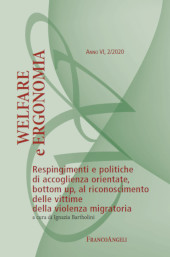Inclusione sociale delle/dei richiedenti asilo, forza e ambivalenze delle "buone pratiche" autorganizzate
31-49 p.
Una lunga ricerca etnografica svoltasi tra il 2015 ed il 2018 a Padova e Provincia, ha porta-to a galla numerose criticità legate all'organizzazione dell'accoglienza dei richiedenti asilo. È stato osservato che la violazione dei diritti emerge nettamente su quelle pratiche di "buona accoglienza" orientate all'implementazione dell'autonomia dei beneficiari e a una loro inclusione sociale improntata alla valorizzazione della loro agency e autodeterminazione. In questo quadro emergenziale, i richiedenti asilo si trovano ora esposti a forme di violenta segregazione e marginalizzazione ora alle prese con la fruizione delle rare risorse "inclusive", spesso subordinata alla completa osservanza delle linee di condotta e disciplinamento stabilite dalle strutture ospitanti e dalla disponibilità allo svolgimento di lavori bassamente qualificati e sottopagati.
In questo contesto paradigma sicuritario e umanitario tendono spesso a intrecciarsi. I confini e le pareti dell'accoglienza però, sia quelle materiali che quelle simboliche, sono spesso flessibili e porose. Negli ultimi anni abbiamo infatti assistito a crescenti processi di "fuoriuscita", volontaria e forzata, dal circuito, un fenomeno recentemente acuito dall'abrogazione della protezione umanitaria e dalla impossibilità del rinnovo della stessa (Legge 132/2018), provvedimenti che espongono i migranti a nuove forme di irregolarizzazione e allo stesso tempo a dinamiche di invisibilizzazione e stigmatizzazione sociale. Questa progressiva permeabilità delle pareti dell'accoglienza ci pone sempre più l'urgenza di indagare a fondo le relazioni tra questi soggetti, le istituzioni e gli attori sociali che abitano il territorio.
A partire da questo proviamo a guardare al ruolo rappresentato da alcune "buone pratiche" autorganizzate dal basso, cercando di capire come esse si misurino con il rischio di riprodurre a loro volta paternalismo e infantilizzazione, tipici ingredienti del modello "assimilazionista" e quanto riescano invece a mettere al centro l'autonomia dei soggetti intercettati. [Testo dell'editore].
A long ethnographic research carried out between 2015 and 2018 in Padua and its Province has exposed numerous critical issues in relation to the reception organization of asylum seekers. It has been observed that rights violation clearly emerges on those "good reception" practices aimed at implementing the autonomy of the beneficiaries and their social inclusion built on the enhancement of their agency and self-determination. In this emergency situation, asylum seekers are now exposed to forms of violent segregation and marginalization, grappling with the use of the rare "inclusive" resources, often subordinated to the complete observance of the lines of conduct and regulation established by the host structures. Moreover, access to the above-mentioned resources may be subject to the asylum seekers availability of performing low-skilled and underpaid jobs.
In this context, the security and humanitarian paradigm often tend to intertwine. However, the borders and walls of reception, both material and symbolic, are often flexible and porous. In fact, in recent years, we have witnessed growing processes of voluntary and forced "escape" from the reception system, a phenomenon recently exacerbated by the repeal of the humanitarian protection and the impossibility of renewing it (Law 132/2018). Such measures have exposed migrants to new forms of irregularization and at the same time to dynamics of invisibility and social stigmatization. This progressive permeability of the reception walls increasingly urges us to investigate the relationships between these subjects and the institutions and social actors that inhabit the territory.
Starting from these considerations we would look at the role represented by a few grassroots "good practices", trying to understand, among the various ones, how they face the risk of recreating paternalism and infantilization, typical ingredients of the "assimilationist" model, and how much they manage to put the autonomy of the intercepted subjects at the core of their work. [Publisher's text].
Is part of
Welfare e ergonomia : VI, 2, 2020-
Articles from the same issue (available individually)
-
Information
ISSN: 2531-9817
DISCIPLINES
KEYWORDS
- Accoglienza, territorio, buone pratiche, autonomia
- Reception, territory, good practices, autonomy



